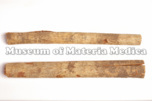Magnolia Bark

|
Market name:和厚朴 Photo location:Museum of Materia Medica, Inst. of Nat. Med. TMPW No.:9717 |

|
Plant name:Magnolia obovata Photo location:Ishikawa Pref., Japan Photo date:1998 Photographer:K. Komatsu |
| Synonym | |
| Latin name | Magnoliae Cortex |
| Botanical source: Family name | Magnoliaceae |
| Botanical source: Plant name | - Magnolia obovata Thunberg (IPNI:554784-1) - Magnolia officinalis Rehder et E.H.Wilson (IPNI:554787-1) - Magnolia officinalis var. biloba Rehder et E.H.Wilson (IPNI:50997083-1) |
| Part used | Dried trunk bark and root bark |
| Empirical criteria for quality selection | The outside of good one is deep violet in color and the inside has longitudinal crests. The bark is very thick and dense. The fresh one, which tastes a little bitter, is good. (NI) |
| Constituents | Monoterpenoids: [M. obovata]: α-Pinene, β-Pinene, Camphene, Limonene, Bornyl acetate Sesquiterpenoids: [M. obovata]: α-Eudesmol, β-Eudesmol(= Machilol), γ-Eudesmol, Cryptomeridiol, Eudesobovatol A, Eudesobovatol B, Caryophyllene epoxide; [M. officinalis]: β-Eudesmol Phenylpropanoids: Magnolol; [M. obovata]: Magnolol(= bis-Chavicol), Honokiol, Magnoloside A, Magnoloside B, Magnoloside C; [M. officinalis]: Magnolol, Honokiol; [M. officinalis, M. obovata]: Magnolol, Honokiol; and the followings are the metabolites: Tetrahydromagnolol, 5-(1-Propen-1(E)-yl)-5'-propyl-2,2'-dihydroxybiphenyl, 5-Allyl-5'-(1-propen-1(E)-yl)-2,2'-dihydroxybiphenyl, Isomagnolol, 5-Allyl-5'-propyl-2,2'-dihydroxybiphenyl; [M. obovata (leaf)]: Obovatal, Obovatol Isoquinoline alkaloids: [M. officinalis, M. obovata]: Magnocurarine, Magnoflorine, Michelalbine, Anonaine, Liriodenine, Salicifoline chloride, Magnocurarine, Magnoflorine |
| Pharmacological effects | Relaxation of muscles (water extract). Sedation,suppression of righting reflex, suppression of spinal reflex, antispasm and antitremor (ether extract). Myoneural junction blokade, transient decrease in blood sugar (magnocurarine). Sedation, central relaxation of muscles, dental caries protection (magnolon, honokio), antibacterial and insecticidal, antiparkinsonism (magnolol). |
| Indications | As an antispasmodic, painkiller, stomachic, astringent, expectorant and diuretic, it is applied to treat abdominal distention and pain, cough and asthma, and abnormal tension of skeletal muscle with anxiety, mental strain and all. |
| Diseases | Full stomach, Abdominal pain, Constipation, Diarrhea, Cough, Dyspnea |
| Formulas | ireito , kakkoshokisan , kamiheiisan , kishukunichinto , kumibinroto , keishikakobokukyoninto , koshaheiisan , koshayoito , kobokusammotsuto , kobokushichimotsuto , kobokushokyohangeninjinkanzoto , goshakusan , saibokuto , shojokito , shobaito , shimpito , jurokumiryukiin , junchoto , senkin'naitakusan , zenshikunshito , soshikokito , daijokito , chokoshiteito , tsudosan , tokito , hachigesan , hangekobokuto , fukankinshokisan , bukuryoingohangekobokuto , bunshoto , heiisan , hokikenchuto , mashiningan |
| Meridian tropism | Spleen, Stomach, Lung, Large intestine |
| Property | Warm |
| Flavor | Bitter, Acrid/pungent |
| Classification in "Shen-non Ben-cao Jing" | Middle |
| TCM: Classification | Dampness-resolving drugs with fragrant odor (Aromatic drugs for resolving dampness) |
| TCM: Medicinal effects | To eliminate damp and to relieve distension. Used for accumulation of damp in the spleen and the stomach marked by epigastric stiffness, vomiting and diarrhea, abdominal distention and constipation due to retention of undigested food, cough and dyspnea caused by retained damp. |
| Remarks | Listed in the Japanese Pharmacopoeia 18th ed. |
| References | NI: N. Isshiki, Methods of Quality Evaluation and Preparation of Wakan-yaku, Tohodo Shoten, Tokyo, 1987. |
DNA sequences of medicinal plants
| Gene Region | |||||||||||||||||||
| Nuclear | Chloroplast | Mitochondria | |||||||||||||||||
| Botanical source: Plant name | 5Ss | 18S | ITS1 | 5.8S | ITS2 | 26S | others | trnH-psbA | matK | trnK | trnK-rps16 | trnT-L | trnL | trnL-F | rbcL | rpoC1 | ndhF | others | |
|
|
|||||||||||||||||||
|
|
|||||||||||||||||||
|
|
|||||||||||||||||||
